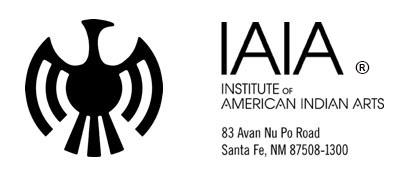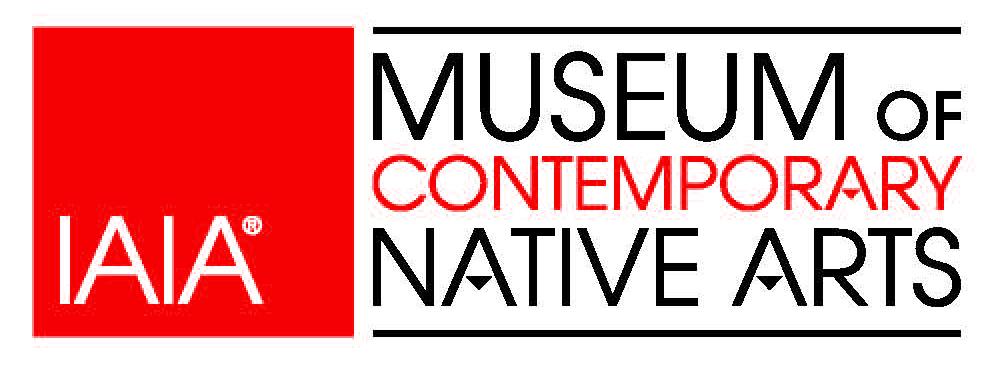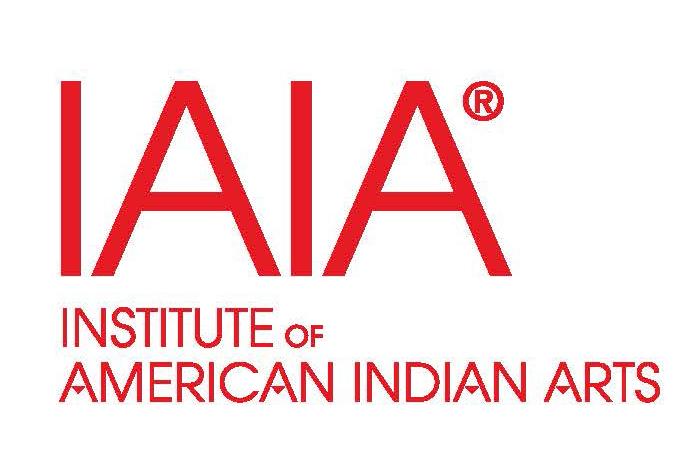|
|
| |


NEWS RELEASE
For Immediate Release
Contact: Eric Davis, Marketing & Communications Director
For press images contact: Sallie Wesaw
Institute of American Indian Arts (IAIA)
Academic Dean and Notable Native Activist and Artist
Charlene Teters
Presents New Installation - Way of Sorrows
at the IAIA Museum of Contemporary Native Arts
Inspired by the crisis at the United States' southern border, Teters shines a light on the harsh reality of the situation
Santa Fe, New Mexico: January 10, 2020
|
|
IAIA Academic Dean and noted
artist, educator, and activist
, Charlene Teters (Spokane) will be presenting Charlene Teters: Way of Sorrows, a new installation that addresses current issues such as forced migrations and the US-Mexico border crisis, from February 7, 2020 - May 17, 2020 in the North Gallery of the IAIA Museum of Contemporary Native Arts in Santa Fe, New Mexico. The Artist Reception for the show will be held February 13, 2020 from 5:00pm to 7:00pm. Teters will be in attendance that evening and plans to debut a newly-developed
Performance Piece designed to go along with the installation.
|
|
Way of Sorrows, installation (detail) by Charlene Teters.
Image courtesy of Don Messec. |
In the past, Teters has spoken of "making artworks that address the realities of the day - and making this reality accessible to viewers". According to her, one of the inspirations for Way of Sorrows was the photo of 2 bodies on the banks of the Rio Grande River that circulated a few months ago on the internet. It was a father with his child still clutched in his arms, both of whom drowned just yards from US soil.
In her Artist's Statement on the exhibition Teters explains:
"Way of Sorrows looks starkly at the birth of savior mythologies, asking 'on whose shoulders does responsibility not reside?' Could it be we are a species best defined as our-own-worse-enemy? Are we truly at a point of some fearing having a little less in order to welcome the stranger who has nothing: no earthly possessions, no place to call home, no place of safety or ceremony? Are we again out of complacency, inaction, cheerleading, or silence -- building silos of hate from fear?
From famine, disease, and empire, Native people have experienced
forced migrations and marches.
There have been many
trails of tears and marches of death
in this hemisphere since Columbus. The caravans of refugees coming to the USA's southern border are part of an uninterrupted history of forced migrations and trails of tears. Those who deny these 'huddled masses' on the US-Mexico border do so, in part, to deny the obvious -- man-made climate crisis may soon make refugees of us all.
No wall will protect us from the wrath of a dying planet.
Walls and armies, policies and politics, hate and dehumanization aimed at hoarding 'The Other, The Temporary' are a fool's errand in the face of impending global disaster.
Way of Sorrows
seeks a spirit of hope represented through photo murals of the artist robed in silver and gold emergency blankets like those given to the desperate, separated, forgotten, and interned refugees around this planet. This is a new new myth of ancient vision and wisdom; the mother-savior -- "
Our Lady of Survival
."
Hope, that we can finally be seen as human beings by each other, and build a future for our collective descendants out of love and respect. Surely, we are all canaries in a mine of our own digging."
The installation's centerpiece is a "Madonna Figure" -- a life-sized photograph of Teters as "Our Lady of Survival" - dressed in regalia made from the thin foil emergency blankets which have been distributed to the adults and children in captivity at the border. The figure, which "represents hope...and possible a Savior," is striking to say the least.
|
|
|
Charlene Teters as "Our Lady of Survival."
| Image courtesy of Don Messec. |
|
Additionally, fencing, dolls, and stuffed animals also made from these emergency blankets will be a part of the installation -- along with Luminarias provided for visitors to write messages of hope that can be left as a growing part of the installation.
Teters has created a stark and striking environment for viewers - not willing to "sugar-coat the heaviness of the issues."
As she remarked: "A platform for conversation is all I could hope for."
In creating the installation, Teters visited the US-Mexico Border wall for a photo shoot. After a somewhat pleasant interaction with the US border patrol, Teters realized that she "did not feel safe there." She'd seen too many images in the media of kids locked up in the concentration camps after being separated from their parents. Kids suffering, shivering in paper-thin foil emergency blankets.
|
|
|
Way of Sorrows,
installation (detail) by
Charlene Teters.
Image courtesy of Don Messec.
|
Dr. Manuela Well-Off-Man
, Chief Curator for the IAIA Museum of Contemporary Native Arts, remarked:
"Way of Sorrows features recent works by Charlene Teters that explore and humanize the complex issues surrounding immigration and the U.S.-Mexican border in thought-provoking ways."
Teters has a history of producing politically-impactful installations.
During the 1999 Site Santa Fe Biennial Looking for a Place, curated by Rosa Martinez, US artists from around the country were invited to participate with works focusing on place.
Teters had observed the Obelisk at the Santa Fe Plaza, which was partially inscribed with the term "savage Indians", had been "modified" when someone chiseled away the word "savage". Teters created her own obelisk which only contained the word "savage," and placed it near the plaza. Her perspective on this installation is that it was not created to be confrontational - merely to spur discussion on the topic.
|
|
|
Charlene Teters and the Obelisk.
Image courtesy of the artist.
|
During a Staff and Faculty show at the Balzer Contemporary Edge Gallery on the IAIA campus, Teters created an installation: #NoToRedSambo.
Here she addressed a subject close to her heart - the use of Native Americans and imagery as mascots. Focused on Chief Wahoo, the image that serves as the logo for Cleveland's major league baseball team, Teters remarked "These images should have gone by the wayside along with Little Black Sambo and the Frito Bandito."
|
|
|
#NoToRedSambo, installation (detail) by
Charlene Teters.
Photo by Jason S. Ordaz. Image courtesy of IAIA.
|
Teters observed: "History can crush you or inspire you, but it all depends on who is telling the story"
Other notable installations/performances/exhibitions by Teters include:
- Only Skin Deep, December 2003-February 2004
- Daily Terrors, Santa Fe Art Institute, Santa Fe, NM
- Over the Edges: The Corners of Ghent, Ghent, Belgium; curated by Jon Hoet
- EV+A 2000, Friends and Neighbors, International Exhibition, Limerick, Ireland; curated by Rosa Martinez
Teters earned an AFA from IAIA, a BFA from the College of Santa Fe, and an MFA from the University of Illinois Urbana-Champaign. In addition, she was awarded an honorary Doctorate of Fine Arts from Mitchell College in New London, CT.
After establishing the Racial Justice Office at the National Congress of American Indians, Teters returned to IAIA in 1992 as Director of Alumni Relations and Student Retention. In 2013, she was promoted to Associate Professor in the Studio Arts Department. She has also served as a Visiting Lecturer in the Art Department at the Ohio State University and received a two-year appointment as the Hugh O. LaBounty Endowed Chair at the California Polytechnic State University in Pomona, CA.
In 2000, Teters was appointed as the Interim Dean of the Academic Division during IAIA's transition and move from the College of Santa Fe campus to their new campus in Rancho Viejo, and named the Academic Dean in 2015.
Teters has exhibited internationally and maintains an active presence lecturing and delivering keynote speeches and commencement addresses across the United States. She first gained national prominence as a graduate student at the University of Illinois Urbana-Champaign where she led protests against the degrading depictions of American Indian caricatures used as sport teams' mascots. Teters' activism has led to a strong upswing in efforts to eliminate Native American mascots in the United States. This history of her activism is the subject of a nationally-aired award- winning documentary "In Whose Honor?" by Jay Rosenstein.
In 2002, she received a New Mexico Governor's Award for Excellence in the Arts. In 2017 she received a Lifetime Achievement Award from the Women's Caucus for the Arts.
Her paintings and art installations have been featured in over 21 major exhibitions, commissions, and collections. Additionally, Teters was the first Artist-in-Residence at the American Museum of Natural History in New York City, New York.
To arrange an interview with Dean Teters, please contact Eric Davis at 505.424.2351, or
eric.davis@iaia.edu.
|
|
About IAIA Museum of Contemporary Native Arts
:
The mission of the IAIA Museum of Contemporary Native Arts (MoCNA) is to advance contemporary Native art through exhibitions, collections, public programs, and scholarship. MoCNA's outreach through local and national collaborations allows us to continue to present the most progressive Native arts and public programming. MoCNA's exhibitions and programs continue the narrative of contemporary Native arts and cultures.
The museum is located at 108 Cathedral Place, Santa Fe, NM 87501. Hours: 10:00 am-5:00 pm Monday & Wednesday-Saturday / 12:00 pm-5:00 pm Sunday / Closed Tuesdays / $10 for adults; half-price for seniors (62+), students w/ valid ID, and NM residents; and free for members, Native people, veterans and their families, youth (16 & under), and NM residents visiting on Sunday. Events are free with admission.
IAIA Museum of Contemporary Native Arts marketing is partially funded by the City of Santa Fe Arts Commission and the 1% Lodgers' Tax.
|
About IAIA: 
For over 50 years, the Institute of American Indian Arts has played a key role in the direction and shape of Native expression. With an internationally acclaimed college, museum, and tribal support resource through the IAIA Land Grant Programs, IAIA is dedicated to the study and advancement of Native arts and cultures -- and committed to student achievement and the preservation and progress of their communities. Learn more about IAIA and our mission at www.iaia.edu. # # # |
|
| |
|
|
|
|
| |
|